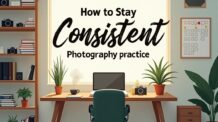In photography, what you don’t include in your frame can be just as powerful as what you do. That’s the beauty of negative space — the empty or “breathing” space around your subject that adds balance, emotion, and clarity to an image. When used thoughtfully, negative space draws attention to your subject and creates a strong visual impact.
In this article, you’ll learn what negative space is, why it matters, and how to use it creatively to elevate your photos — regardless of the subject or style.
What Is Negative Space?
Negative space is the area that surrounds the main subject (also called positive space) in a photo. It’s usually minimal, uncluttered, and simple — but not unimportant.
It can take the form of:
- A blank wall
- Open sky
- Water
- Sand
- Fog
- Solid color backgrounds
- Any area that contrasts with and emphasizes the subject
Negative space gives your subject room to breathe and creates a sense of calm, isolation, or focus.
Why Use Negative Space?
Using negative space can transform an average photo into a striking one. Here’s why it’s effective:
- Emphasizes the subject by reducing distractions
- Creates mood, such as loneliness, freedom, peace, or openness
- Improves composition by adding balance and simplicity
- Leads the viewer’s eye directly to the focal point
- Adds depth and a sense of scale to the image
It’s especially useful in minimalist photography, but it can enhance any genre — from portrait and landscape to street and product photography.
Composition Tips for Using Negative Space
1. Use the Rule of Thirds
Place your subject off-center (at one-third of the frame) and leave the rest of the image empty. This creates a dynamic balance and naturally leads the viewer’s eye to the subject.
Negative space acts as a visual pause that highlights the main element.
2. Simplify the Background
The more minimal your background, the more powerful your negative space becomes. Look for:
- Clear skies
- Plain walls
- Empty streets
- Wide open landscapes
Use shallow depth of field (wide aperture like f/2.8) to blur busy backgrounds if they can’t be avoided.
3. Play with Scale
Use a wide-angle lens to capture vast areas around a small subject. This emphasizes the contrast between subject and space and gives your image emotional weight — great for evoking solitude or grandeur.
For example: a single person walking on a beach or standing in a wide-open desert.
4. Use Color and Contrast
Negative space doesn’t have to be white or gray. It can be filled with rich color or texture, as long as it doesn’t compete with the subject.
Look for color contrast:
- A red umbrella against a blue sky
- A person in dark clothes standing in front of a white wall
- A yellow flower on green grass
The key is to make sure the subject pops against the space around it.
5. Create Mood with Emptiness
Use negative space to evoke emotion:
- Peace and stillness with clean, soft tones
- Loneliness with wide open or foggy spaces
- Freedom with endless skies or empty roads
It’s not just about minimalism — it’s about storytelling.
Negative Space in Different Photography Genres
Portrait Photography:
- Use a blank background or open sky to isolate the subject
- Position the person to one side, leaving space around them
- Let the negative space reflect their emotional state (joy, calm, isolation)
Landscape Photography:
- Let skies, fields, or oceans dominate the frame
- Emphasize the vastness of nature compared to small human or animal elements
Street Photography:
- Capture people walking through empty urban spaces
- Use walls, sidewalks, or geometric shapes as simple backgrounds
Product Photography:
- Use empty space to make the product the clear focus
- Helps with branding and commercial usage, especially in ads
Common Mistakes to Avoid
- Too much negative space: If the subject becomes too small or lost, the viewer may feel disconnected
- Distracting backgrounds: Busy or cluttered “empty” spaces defeat the purpose
- Poor exposure: Large white or black areas can be tricky — watch for overexposure or loss of detail
- No focal point: Even with a lot of space, the subject still needs to stand out clearly
Use negative space intentionally — not just because there’s “nothing else” to include.
Practice Ideas
- Photograph a single object against a plain wall
- Shoot from above with a flat surface as the background
- Frame a person walking through a large open field
- Experiment with different lighting conditions to see how light and shadow affect space
Review your photos and ask: does the space support or distract from the subject?
Final Thoughts
Negative space is a powerful creative tool that helps your subject stand out while creating emotion, balance, and visual clarity. It’s not just about what you include in the frame — it’s also about what you leave out.
So next time you pick up your camera, don’t just look at your subject — look at the space around it. Use that space to elevate your composition, amplify your story, and create more compelling images.




Deixe um comentário